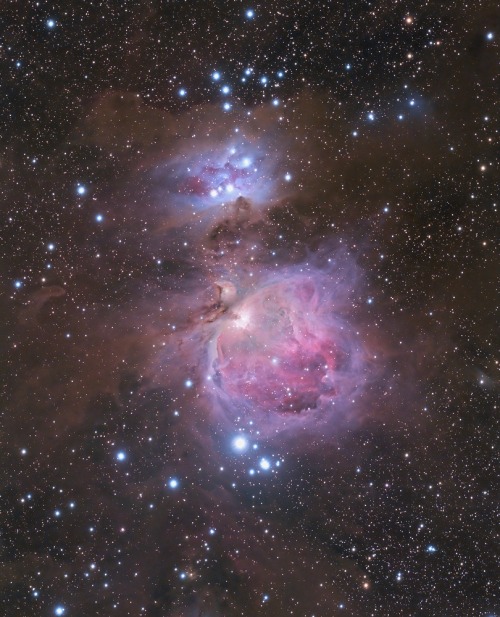Scorpio, Milky Way And Jupiter

Scorpio, Milky Way and Jupiter
More Posts from Chbnb and Others

Marian Lake, Fiordlands, New Zealand | dylangehlken_photography

Orion rising over Death Valley // Brett Nickeson
A few easily-spotted nebulae include Barnard's Loop and the Orion Nebula
“There’s as many atoms in a single molecule of your DNA as there are stars in the typical galaxy. We are, each of us, a little universe.”
—
Neil deGrasse Tyson, Cosmos


that is amazing

Corona Australis

The Full Moon of 2021 via NASA https://ift.tt/3FWxNTm
Every Full Moon of 2021 shines in this year-spanning astrophoto project, a composite portrait of the familiar lunar nearside at each brightest lunar phase. Arranged by moonth, the year progresses in stripes beginning at the top. Taken with the same camera and lens the stripes are from Full Moon images all combined at the same pixel scale. The stripes still looked mismatched, but they show that the Full Moon’s angular size changes throughout the year depending on its distance from Kolkata, India, planet Earth. The calendar month, a full moon name, distance in kilometers, and angular size is indicated for each stripe. Angular size is given in minutes of arc corresponding to 1/60th of a degree. The largest Full Moon is near a perigee or closest approach in May. The smallest is near an apogee, the most distant Full Moon in December. Of course the full moons of May and November also slid into Earth’s shadow during 2021’s two lunar eclipses.
(Published January 01, 2022)

NGC 602 In The Flying Lizard Nebula

The Orion Nebula (M42), M43 and the Running Man Nebula.
Credit: Chad Quandt



Sunset on Pluto
-
 nijaded liked this · 11 months ago
nijaded liked this · 11 months ago -
 kocurek1921 liked this · 11 months ago
kocurek1921 liked this · 11 months ago -
 buggzarronumber1 reblogged this · 11 months ago
buggzarronumber1 reblogged this · 11 months ago -
 buggzarronumber1 liked this · 11 months ago
buggzarronumber1 liked this · 11 months ago -
 dulcesmejillasrosadas-97blog liked this · 2 years ago
dulcesmejillasrosadas-97blog liked this · 2 years ago -
 cherrywinestained reblogged this · 2 years ago
cherrywinestained reblogged this · 2 years ago -
 mattbastard liked this · 2 years ago
mattbastard liked this · 2 years ago -
 starsgivemehp reblogged this · 2 years ago
starsgivemehp reblogged this · 2 years ago -
 the-summer-sun-au liked this · 2 years ago
the-summer-sun-au liked this · 2 years ago -
 o-os reblogged this · 2 years ago
o-os reblogged this · 2 years ago -
 o-os liked this · 2 years ago
o-os liked this · 2 years ago -
 yeryuzugokyuzu liked this · 2 years ago
yeryuzugokyuzu liked this · 2 years ago -
 larimar reblogged this · 2 years ago
larimar reblogged this · 2 years ago -
 larimar liked this · 2 years ago
larimar liked this · 2 years ago -
 nathaniels-diary liked this · 2 years ago
nathaniels-diary liked this · 2 years ago -
 nachtwandler59 liked this · 2 years ago
nachtwandler59 liked this · 2 years ago -
 dewinkelvansinkel reblogged this · 2 years ago
dewinkelvansinkel reblogged this · 2 years ago -
 dewinkelvansinkel liked this · 2 years ago
dewinkelvansinkel liked this · 2 years ago -
 sunshineswimmer23 liked this · 2 years ago
sunshineswimmer23 liked this · 2 years ago -
 gemezs liked this · 2 years ago
gemezs liked this · 2 years ago -
 namelessfeeling liked this · 3 years ago
namelessfeeling liked this · 3 years ago -
 pleasurefortwo reblogged this · 3 years ago
pleasurefortwo reblogged this · 3 years ago -
 everydayesterday reblogged this · 3 years ago
everydayesterday reblogged this · 3 years ago -
 everydayesterday liked this · 3 years ago
everydayesterday liked this · 3 years ago -
 solareclipseo reblogged this · 3 years ago
solareclipseo reblogged this · 3 years ago -
 veeshadirus reblogged this · 3 years ago
veeshadirus reblogged this · 3 years ago -
 bxttercxpp liked this · 3 years ago
bxttercxpp liked this · 3 years ago -
 john-erby liked this · 3 years ago
john-erby liked this · 3 years ago -
 philipwoj liked this · 3 years ago
philipwoj liked this · 3 years ago -
 wiredawake reblogged this · 3 years ago
wiredawake reblogged this · 3 years ago -
 lemihworld reblogged this · 3 years ago
lemihworld reblogged this · 3 years ago -
 lemihworld liked this · 3 years ago
lemihworld liked this · 3 years ago -
 i-am-a-polpetta liked this · 3 years ago
i-am-a-polpetta liked this · 3 years ago -
 givemeanorigami reblogged this · 3 years ago
givemeanorigami reblogged this · 3 years ago -
 ehlnofaey reblogged this · 3 years ago
ehlnofaey reblogged this · 3 years ago -
 kibellah reblogged this · 3 years ago
kibellah reblogged this · 3 years ago -
 kibellah liked this · 3 years ago
kibellah liked this · 3 years ago -
 godlyrot liked this · 3 years ago
godlyrot liked this · 3 years ago -
 vpviewlpy liked this · 3 years ago
vpviewlpy liked this · 3 years ago





